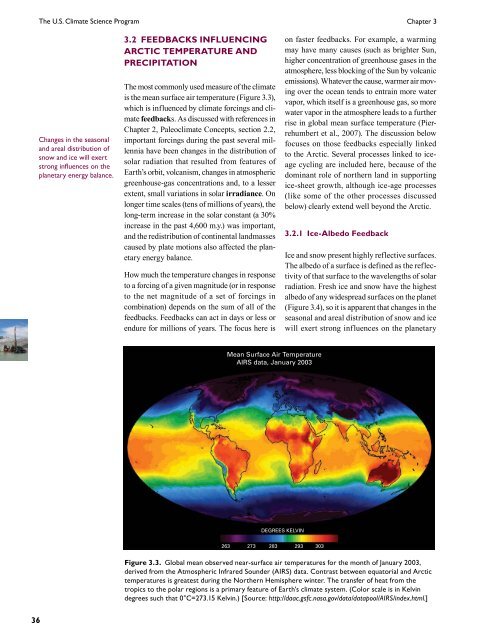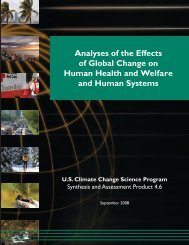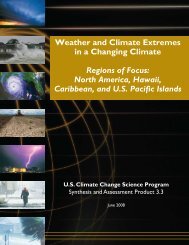Past Climate Variability and Change in the Arctic and at High Latitudes
Past Climate Variability and Change in the Arctic and at High Latitudes
Past Climate Variability and Change in the Arctic and at High Latitudes
Create successful ePaper yourself
Turn your PDF publications into a flip-book with our unique Google optimized e-Paper software.
36<br />
The U.S. <strong>Clim<strong>at</strong>e</strong> Science Program Chapter 3<br />
<strong>Change</strong>s <strong>in</strong> <strong>the</strong> seasonal<br />
<strong>and</strong> areal distribution of<br />
snow <strong>and</strong> ice will exert<br />
strong <strong>in</strong>fluences on <strong>the</strong><br />
planetary energy balance.<br />
3.2 FEEDBACKS INFLUENCING<br />
ARCTIC TEMPERATURE AND<br />
PRECIPITATION<br />
The most commonly used measure of <strong>the</strong> clim<strong>at</strong>e<br />
is <strong>the</strong> mean surface air temper<strong>at</strong>ure (Figure 3.3),<br />
which is <strong>in</strong>fluenced by clim<strong>at</strong>e forc<strong>in</strong>gs <strong>and</strong> clim<strong>at</strong>e<br />
feedbacks. As discussed with references <strong>in</strong><br />
Chapter 2, Paleoclim<strong>at</strong>e Concepts, section 2.2,<br />
important forc<strong>in</strong>gs dur<strong>in</strong>g <strong>the</strong> past several millennia<br />
have been changes <strong>in</strong> <strong>the</strong> distribution of<br />
solar radi<strong>at</strong>ion th<strong>at</strong> resulted from fe<strong>at</strong>ures of<br />
Earth’s orbit, volcanism, changes <strong>in</strong> <strong>at</strong>mospheric<br />
greenhouse-gas concentr<strong>at</strong>ions <strong>and</strong>, to a lesser<br />
extent, small vari<strong>at</strong>ions <strong>in</strong> solar irradiance. On<br />
longer time scales (tens of millions of years), <strong>the</strong><br />
long-term <strong>in</strong>crease <strong>in</strong> <strong>the</strong> solar constant (a 30%<br />
<strong>in</strong>crease <strong>in</strong> <strong>the</strong> past 4,600 m.y.) was important,<br />
<strong>and</strong> <strong>the</strong> redistribution of cont<strong>in</strong>ental l<strong>and</strong>masses<br />
caused by pl<strong>at</strong>e motions also affected <strong>the</strong> planetary<br />
energy balance.<br />
How much <strong>the</strong> temper<strong>at</strong>ure changes <strong>in</strong> response<br />
to a forc<strong>in</strong>g of a given magnitude (or <strong>in</strong> response<br />
to <strong>the</strong> net magnitude of a set of forc<strong>in</strong>gs <strong>in</strong><br />
comb<strong>in</strong><strong>at</strong>ion) depends on <strong>the</strong> sum of all of <strong>the</strong><br />
feedbacks. Feedbacks can act <strong>in</strong> days or less or<br />
endure for millions of years. The focus here is<br />
Mean Surface Air Temper<strong>at</strong>ure<br />
AIRS d<strong>at</strong>a, January 2003<br />
DEGREES KELVIN<br />
263 273 283 293 303<br />
on faster feedbacks. For example, a warm<strong>in</strong>g<br />
may have many causes (such as brighter Sun,<br />
higher concentr<strong>at</strong>ion of greenhouse gases <strong>in</strong> <strong>the</strong><br />
<strong>at</strong>mosphere, less block<strong>in</strong>g of <strong>the</strong> Sun by volcanic<br />
emissions). Wh<strong>at</strong>ever <strong>the</strong> cause, warmer air mov<strong>in</strong>g<br />
over <strong>the</strong> ocean tends to entra<strong>in</strong> more w<strong>at</strong>er<br />
vapor, which itself is a greenhouse gas, so more<br />
w<strong>at</strong>er vapor <strong>in</strong> <strong>the</strong> <strong>at</strong>mosphere leads to a fur<strong>the</strong>r<br />
rise <strong>in</strong> global mean surface temper<strong>at</strong>ure (Pierrehumbert<br />
et al., 2007). The discussion below<br />
focuses on those feedbacks especially l<strong>in</strong>ked<br />
to <strong>the</strong> <strong>Arctic</strong>. Several processes l<strong>in</strong>ked to iceage<br />
cycl<strong>in</strong>g are <strong>in</strong>cluded here, because of <strong>the</strong><br />
dom<strong>in</strong>ant role of nor<strong>the</strong>rn l<strong>and</strong> <strong>in</strong> support<strong>in</strong>g<br />
ice-sheet growth, although ice-age processes<br />
(like some of <strong>the</strong> o<strong>the</strong>r processes discussed<br />
below) clearly extend well beyond <strong>the</strong> <strong>Arctic</strong>.<br />
3.2.1 Ice-Albedo Feedback<br />
Ice <strong>and</strong> snow present highly reflective surfaces.<br />
The albedo of a surface is def<strong>in</strong>ed as <strong>the</strong> reflectivity<br />
of th<strong>at</strong> surface to <strong>the</strong> wavelengths of solar<br />
radi<strong>at</strong>ion. Fresh ice <strong>and</strong> snow have <strong>the</strong> highest<br />
albedo of any widespread surfaces on <strong>the</strong> planet<br />
(Figure 3.4), so it is apparent th<strong>at</strong> changes <strong>in</strong> <strong>the</strong><br />
seasonal <strong>and</strong> areal distribution of snow <strong>and</strong> ice<br />
will exert strong <strong>in</strong>fluences on <strong>the</strong> planetary<br />
Figure 3.3. Global mean observed near-surface air temper<strong>at</strong>ures for <strong>the</strong> month of January 2003,<br />
derived from <strong>the</strong> Atmospheric Infrared Sounder (AIRS) d<strong>at</strong>a. Contrast between equ<strong>at</strong>orial <strong>and</strong> <strong>Arctic</strong><br />
temper<strong>at</strong>ures is gre<strong>at</strong>est dur<strong>in</strong>g <strong>the</strong> Nor<strong>the</strong>rn Hemisphere w<strong>in</strong>ter. The transfer of he<strong>at</strong> from <strong>the</strong><br />
tropics to <strong>the</strong> polar regions is a primary fe<strong>at</strong>ure of Earth’s clim<strong>at</strong>e system. (Color scale is <strong>in</strong> Kelv<strong>in</strong><br />
degrees such th<strong>at</strong> 0°C=273.15 Kelv<strong>in</strong>.) [Source: http://daac.gsfc.nasa.gov/d<strong>at</strong>a/d<strong>at</strong>apool/AIRS/<strong>in</strong>dex.html.]




